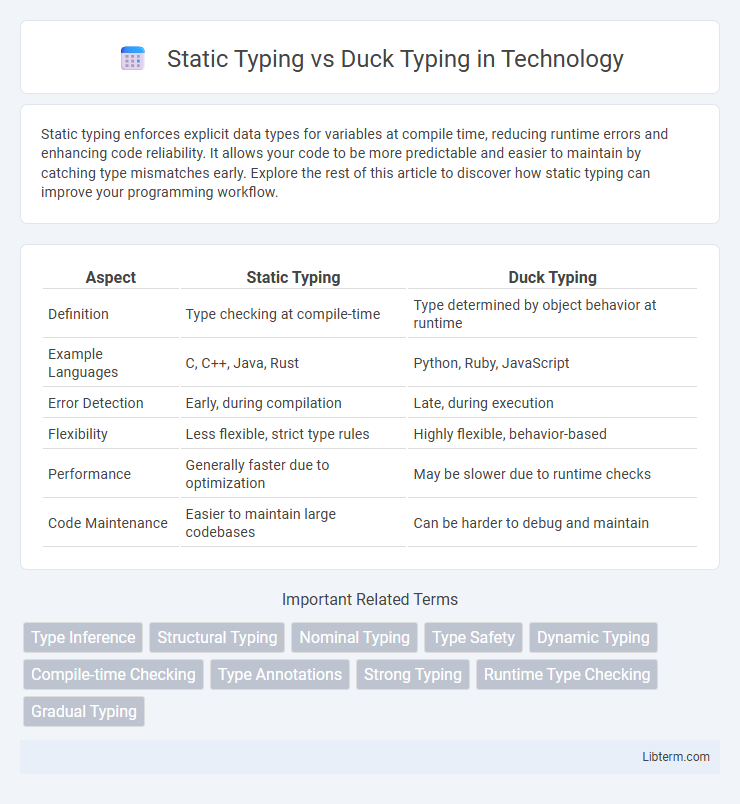Static typing enforces explicit data types for variables at compile time, reducing runtime errors and enhancing code reliability. It allows your code to be more predictable and easier to maintain by catching type mismatches early. Explore the rest of this article to discover how static typing can improve your programming workflow.
Table of Comparison
| Aspect | Static Typing | Duck Typing |
|---|---|---|
| Definition | Type checking at compile-time | Type determined by object behavior at runtime |
| Example Languages | C, C++, Java, Rust | Python, Ruby, JavaScript |
| Error Detection | Early, during compilation | Late, during execution |
| Flexibility | Less flexible, strict type rules | Highly flexible, behavior-based |
| Performance | Generally faster due to optimization | May be slower due to runtime checks |
| Code Maintenance | Easier to maintain large codebases | Can be harder to debug and maintain |
Introduction to Type Systems
Static typing enforces variable types at compile time, ensuring type safety and error detection before program execution, commonly used in languages like Java and C++. Duck typing, prominent in dynamic languages such as Python and Ruby, determines type compatibility based on the presence of specific methods or properties rather than explicit type declarations. Type systems serve as frameworks that define how types are assigned, checked, and enforced, influencing code reliability, maintainability, and flexibility across different programming paradigms.
What is Static Typing?
Static typing is a programming language feature where variable types are explicitly declared and checked at compile time, ensuring type correctness before code execution. It enables early detection of type errors, improves code reliability, and enhances IDE support through features like autocompletion and refactoring. Languages such as Java, C++, and Rust exemplify static typing by enforcing strict type constraints during compilation.
What is Duck Typing?
Duck typing is a dynamic typing method used in programming where an object's suitability is determined by the presence of specific methods and properties rather than its actual type. This approach allows functions to accept any object that implements the required behavior, promoting flexibility and code reusability. Popular in languages like Python and Ruby, duck typing emphasizes "if it walks like a duck and quacks like a duck, it must be a duck" to focus on capabilities over formal class inheritance.
Key Differences Between Static and Duck Typing
Static typing involves explicitly declaring variable types at compile-time, enabling early error detection and optimizing performance. Duck typing, common in dynamic languages, determines an object's suitability by the presence of methods and properties at runtime, promoting flexibility and rapid development. The key difference lies in static typing's strict type enforcement versus duck typing's emphasis on object behavior rather than formal type definitions.
Code Examples: Static vs Duck Typing
Static typing requires variable data types to be declared explicitly, enabling the compiler to catch type errors before runtime, as seen in languages like Java: `int number = 5;`. Duck typing, common in dynamically typed languages such as Python, relies on the presence of methods and properties rather than explicit type declarations, exemplified by passing any object with a `quack()` method to a function. Code examples highlight that static typing provides early error detection and improved tooling support, while duck typing offers greater flexibility and developer speed during rapid prototyping.
Benefits of Static Typing
Static typing offers early error detection by enforcing type rules at compile time, reducing runtime bugs and improving code reliability. It enhances code clarity and maintainability by explicitly defining variable types, facilitating easier debugging and refactoring. Strong static typing also enables advanced IDE features such as autocompletion and type inference, boosting developer productivity and code quality.
Advantages of Duck Typing
Duck typing offers significant flexibility by allowing objects to be used based on their behaviors rather than their class hierarchies, enabling smoother code reuse and simpler interfaces. It reduces the need for explicit type declarations, which accelerates development and supports more dynamic, readable code. This approach enhances polymorphism and eases integration with diverse data types, fostering agile software design and rapid prototyping.
Common Pitfalls and Limitations
Static typing enforces explicit type declarations, which helps catch type-related errors at compile time but can lead to rigidity and verbose code, limiting flexibility in dynamic scenarios. Duck typing relies on an object's methods and properties rather than its class, allowing more flexible and extensible code but making it prone to runtime errors due to missing or incorrectly implemented behaviors. Common pitfalls of static typing include difficulty managing complex type hierarchies and slower development speed, while duck typing risks runtime crashes and harder-to-debug issues without rigorous testing.
Use Cases: When to Choose Each Approach
Static typing is ideal for large-scale software projects requiring early error detection, enhanced code maintainability, and robust tooling support, such as financial applications and system software. Duck typing suits dynamic environments like rapid prototyping, scripting, and small to medium web applications where flexibility and faster development outweigh strict type constraints. Choosing between static and duck typing depends on the trade-off between safety and agility, with static typing offering compile-time guarantees and duck typing enabling polymorphism through behavior rather than explicit type declarations.
Conclusion: Choosing the Right Typing Strategy
Static typing enhances code reliability by catching type errors at compile time, making it ideal for large, complex projects requiring maintainability and robust error checking. Duck typing offers flexibility and faster development cycles by determining object usability based on behavior rather than explicit types, suiting dynamic and rapidly evolving codebases. Selecting the right typing strategy depends on project scale, team expertise, and the need for either strict type safety or development agility.
Static Typing Infographic

 libterm.com
libterm.com